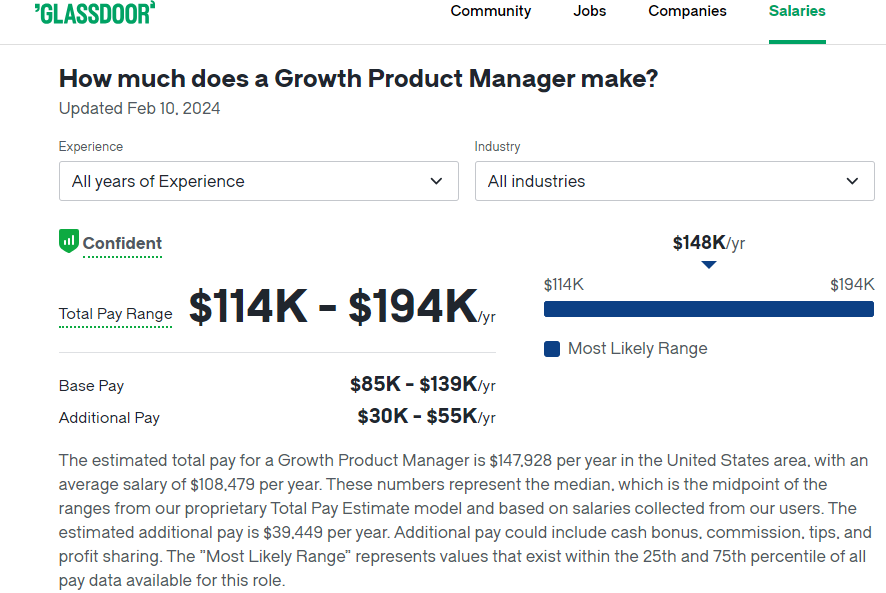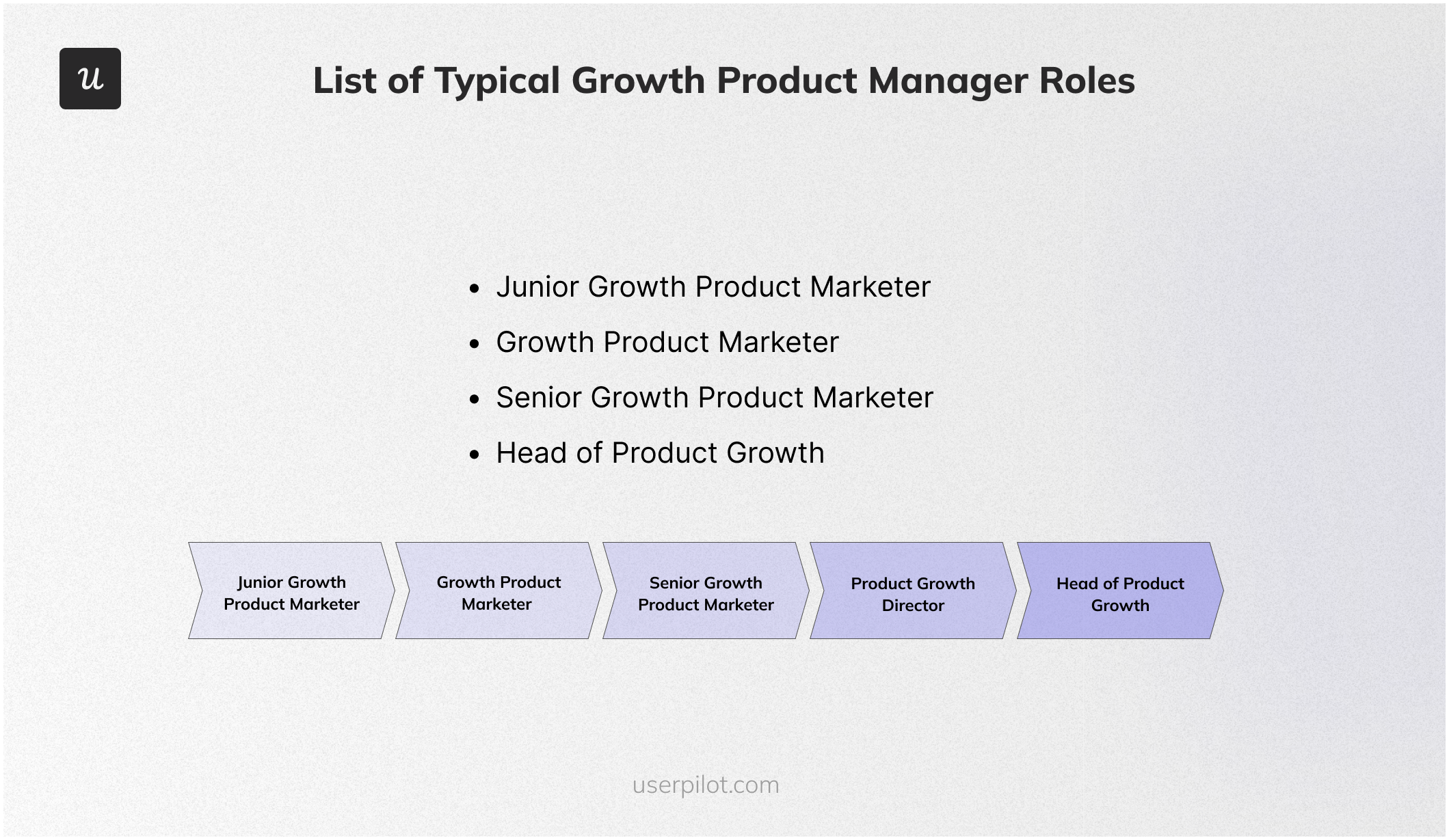![Growth Product Manager Salary [+ Resources to Advance]](https://blog-static.userpilot.com/blog/wp-content/uploads/2024/06/Growth-Product-Manager-SalaryResources-to-Advance.png)
Growth Product Manager Salary [+ Resources to Advance]8 min read
Understanding the salary landscape for growth product managers is crucial whether you’re entering the field or looking to advance your career.
In this guide, we’ll provide an overview of typical growth product manager salaries, explore factors that can influence earnings, and share valuable resources to help you progress in your career.
Get The Insights!
The fastest way to learn about Product Growth, Management & Trends.
What is a growth product manager?
Growth product manager is a specialist position within product management focusing on identifying and executing product-led growth opportunities in acquisition, engagement, and retention.
Unlike traditional product managers responsible for owning a specific product’s vision and roadmap, growth product managers focus on a specific business goal or metric. That goal can relate to any point of the customer journey, from acquisition to retention and expansion.
Along with such goals, growth managers are also in charge of growth metrics, like improving Customer Acquisition Cost (CAC) and activation rate.
Growth product manager’s main responsibilities
The main goal of any growth product manager is to drive sustainable growth by focusing on three key elements within the customer lifecycle: acquisition, engagement, and retention.
To ensure success in either of these components, there are multiple other responsibilities the growth manager must perform well. Let’s look at what these are.
- Define the company’s growth goals and prioritize direction, ensuring alignment with overall business objectives.
- Identify experience gaps through various analyses performed, such as funnel or path analysis.
- Measure progress by tracking select metrics, interpreting the results, preparing detailed reports for all to understand, and uncovering any product problem points or improvement areas.
- Regularly analyze customer behavior through both quantitative and qualitative means. This includes product usage and trend analysis, usability tests, and feedback collection.
- Build and execute experiments and tests, typically in collaboration with marketing, development, and design teams, to understand what customers engage with better.
- Increase the customer lifetime value by identifying opportunities for upsells and cross-sells to ultimately drive revenue retention.
- Optimize user onboarding to improve the initial customer experience, creating supplementary onboarding materials and guides to help customers reduce time to value.
- Stay on top of the changing market dynamics through continuous research on the industry and competitor actions.
- Effectively communicate growth goals and progress across departments to ensure cohesive commitment and execution.
- Manage the budget for all growth initiatives, keeping an eye on ROI for all growth activities and campaigns.
How much does a growth product manager make?
Experience has the biggest impact on how much you can earn. Here’s how your level of work experience can impact your growth product manager salary, according to Glassdoor:
- 1 to 3 years (Growth Manager): $144,485/year
- 4 to 6 years (Senior Growth Manager): $159,244/year
- 7 to 9 years (Growth Director): $166,916/year
- 10+ years (Head of Growth): $184,862/year
There are some industries where the role of a growth product manager is in great demand, which also means a higher salary. Here are a few of those industries, along with the salaries they offer:
- Agriculture: $186,000/year
- Healthcare: $183,000/year
- Information Technology: $171,000/year
Apart from these two factors, location is another important element that can greatly impact the growth of a product manager’s salary. According to Glassdoor, here are the average salaries for this role in some big US cities:
- New York: $133,309/year
- San Francisco: $149,590/year
- Austin: $137,741/year
- Washington, DC: $131,110/year
- Chicago: $126,779/year
Growth product manager career path
- Junior Growth Product Marketer: The focus at the very start is on gaining a deep understanding of growth metrics and strategies, acquisition channels, and different analytical tools.
- Growth Product Manager: In this role, you will be given more responsibilities to find growth opportunities and design and execute appropriate growth strategies to capitalize on them.
- Senior Growth Product Manager: This role demands more ownership, as you will lead growth initiatives and partake in strategic decisions for all products while mentoring junior peers as well.
- Product Growth Director: At this point, you oversee the overall growth strategy and implementation, coordinating between departments and actively dealing with stakeholders.
- Head of Product Growth: Once you reach the top, you’re responsible for defining the company’s growth objectives and ensuring they are aligned with the company’s business goals.
Best practices to be a great growth product manager
Since a growth product manager has to constantly juggle multiple tasks, they can sometimes lose focus on what’s important. To help with that, here are five crucial best practices that every growth manager should religiously follow.
- Data is your best friend: To truly nail product growth, all your strategies need to be data-driven because the numbers don’t lie. This means growth managers must be incredibly adept at data handling, performance tracking, and analytics.
- Keep customers at the heart of all strategies: Growth is only possible if you produce something customers like that caters to their needs and pain points. This is why growth managers heavily rely on customer feedback to drive product enhancements.
- Experiment, experiment, and experiment: A great growth product manager brings with them a culture of creativity, testing, and continuous discovery. Experiments should drive all innovation, from marketing campaigns to new feature development.
- Balance both acquisition and retention: A key mistake most growth product managers make is focusing too heavily on new customer acquisition and ignoring retention. Do better and balance both to drive long-term business growth.
- Always keep an eye on the market: Don’t get so hyper-fixated on your strategies that you completely ignore what’s going on in the market. Instead, stay up to date on the latest trends and tools and attend professional networking events to remain relevant.
Best resources for growth product managers
There are a ton of resources available out there to utilize for growing your growth product management portfolio. Here, we list down the best books, webinars, podcasts and more that you should definitely check out!
Best books for growth product managers
- “Hacking Growth: How Today’s Fastest-Growing Companies Drive Breakout Success” by Sean Ellis and Morgan Brown
- Description: Discusses the proven tactics and implementable techniques used by high-growth companies to achieve rapid expansion.
- Where to find: Available on Amazon, Barnes & Noble, and other major book retailers.
- “The Lean Startup: How Today’s Entrepreneurs Use Continuous Innovation to Create Radically Successful Businesses” by Eric Ries
- Description: Discusses Ries’ lean startup strategy, applicable to agile SaaS companies as well, of rapid experimentation and iterative product development.
- Where to find: Available on Amazon, Apple Books, and other major book retailers.
Best webinars for growth product managers
Growth product managers are the strategists behind user acquisition and engagement. So here’s a curated list of top webinar sources to empower you across user acquisition, product engagement, and growth strategies:
- Userpilot Events remains your go-to for user onboarding and product growth. Their webinars delve into user acquisition strategies, feature adoption tactics, and user engagement optimization – all crucial for growth PMs.
- Chargebee hosts webinars focused on subscription billing and revenue optimization strategies. These are crucial aspects for growth product managers, especially for SaaS products.
- GrowthHackers hosts webinars featuring industry leaders on growth hacking strategies, user acquisition techniques, and growth experimentation methodologies.
- Product School offers webinars on a range of topics, including growth product management. You can look for webinars on growth hacking, user acquisition channels, and experimentation frameworks.
Best blogs for growth product managers
- Userpilot’s blog: Discover a wealth of articles, guides, and case studies revolving around product management, user experiences, and product-led growth. Available on their website under the resources section.
- Andrew Chen’s Blog: A guru in the field of growth hacking, Chen’s blog offers in-depth analysis and tried-and-tested advice on growth strategies, especially around acquisition and retention.
Best podcasts for growth product managers
- “Masters of Scale” by Reid Hoffman
- Description: Learn from iconic business leaders as they share insights on how they scaled their companies to drive growth and become some of the greatest in the world.
- Where to find: Available on Apple Podcasts, Spotify, and the Masters of Scale website.
- “Growth Podcast” by Sean Ellis
- Description: Hosted by a pioneer of growth hacking himself, the podcast includes interviews with leading experts in growth marketing and product management to learn lessons on driving product growth.
- Where to find: Available on Apple Podcasts, Spotify, and Google Podcasts.
Best tools for growth product managers
- Best tool for data analytics and visualization – Userpilot: Enables you to track in-app user behavior across multiple touchpoints and perform comprehensive analytics, utilizing custom dashboards and charts for easy visualization.
- Master efficient project management with Trello: Organize growth strategies into smaller, deliverable tasks, easily coordinate across multiple teams, assign necessary resources, monitor resource utilization, and track progress.
- Transform product management workflows with Confluence: Simplify collaboration and information sharing amongst various teams by establishing a centralized knowledge base, helping align decision-making throughout the product lifecycle.
- Top design tool for optimizing user experiences – Figma: Unlock customer experience insights by using this collaborative platform for designing and prototyping new features and developments, ensuring that they align with customer needs.
- Leverage Zendesk to proactively resolve CX issues: Stay on top of customer support interactions, extract useful feedback, and identify recurring issues. Use all this information to prioritize proactive product improvements.
Conclusion
Now that you have a better understanding of the salary range for a growth product manager position, you can take steps to improve your earning potential. Consider pursuing relevant certifications, developing your skillset, or negotiating effectively during the job offer stage.
Looking into tools for growth product managers? Userpilot is an all-in-one product platform with engagement features and powerful analytics capabilities. Book a demo to see it in action!









